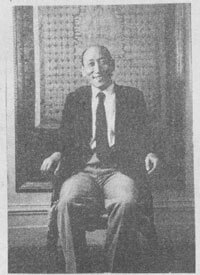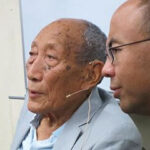| The following article is from the Winter, 1986 issue of the Snow Lion Newsletter and is for historical reference only. You can see this in context of the original newsletter here. |
In 1928, the elder monks of the Gelugpa sect of Tibetan Buddhism divined that a five-year-old boy living in a remote part of Tibet was the reincarnation of the ninth Khyongla of Tibet. On the boy's sixth birthday, monks on horseback took him from his parents to a monastery some distance away, where he was installed as its spiritual head. For three decades, he underwent intensive training in Tibetan Buddhist tenets and meditation. Upon completion of the arduous training which included debate, dialectics, and deep study of the tenet systems, as well as continual meditation practice, Rinnoche passed his Geshe lharampa exam.
Candidates for the lharampa, highest of the geshe degrees, were chosen by the abbots and their names were forwarded to the Dalai Lama. The Dalai Lama's assistants subjected the candidate to a two or three day preliminary examination. Anyone failing was sent back to his college to be examined there for one or another of the lesser degrees. If he passed the preliminary exam, he could take the lharampa exam. The lharampa examination was taken before the entire congregation of the three great monasteries when they gathered annually for the Monlam festival in Lhasa. The lharampa degree was regarded as the most important degree for several reasons. It required usually twenty-six years of intense monastic study to be able to pass it and represents the highest scholarship. The final phase of examination took place in the great Jokhang Temple in Lhasa, before Jowo Rinpoche, the most revered image of the Lord Buddha in the country. Moreover, the Monlam festival drew the largest congregation of scholar-monks in the world, including those from the Three Pillarsas well as many from other parts of Tibet; and all the Gelugpa monasteries preferred to choose as abbots monks who had taken this degree. The abbots of Sera, Drepung, and Gaden were usually chosen from the highest placed lharampa geshes, and it was a rare thing to find in any of those major monasteries an abbot without this degree. One further reason for the importance of the lharampa was that it was a prerequisite for a degree in Tantric Buddhism from the Gyudpa colleges, and this, in turn, was a prerequisite to becoming Gaden Tri Rinpoche, head of the whole Gelugpa hierarchy.

Khyongla Rato Rinpoche
In addition to the above mentioned training in Buddhist philosophy, very intense and austere meditation practice went on continuously with frequent solitary retreats.
Upon completion of his Geshe lharampa degree, Khyongla Rato Rinpoche entered the Gyuto Tantric college. An intimate friend and protege of the tutors of the young Dalai I.ama. Khyongla had been himself among the number of recognized scholars appointed to examine His Holiness when the Dalai Lama received his lharampa geshe degree. Rinpoche fled the Chinese invasion of Tibet in 1959 and now lives quietly in New York City. Although extremely humble and leading a quiet life, he is considered by other lamas to be a great scholar and tantric master. He wrote a wonderful detailed biography of his life in Tibet and his training as a monk, his escape from the Chinese invasion, life in India and his transition to life in the West. Dutton originally published a very abridged version of this biography but unfortunately left out those things which are most interesting to a student of Buddhism. Snow Lion Publications plans to publish the work in its entirety (nearly 700 pages complete with maps and heavily illustrated) under the title Memoirs ofa Tibetan lama. This will be the most detailed, fullblooded, and intimate narative of the life of a Tibetan lama and monastic training ever published and will be a very important historical document.

